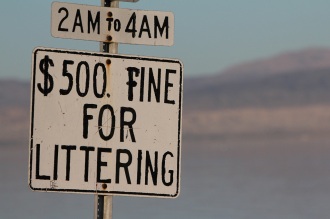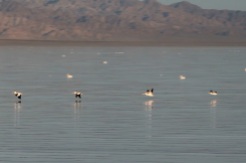
One would think that the most obvious question when you come to the seaside is, “How do you get to the water?” There are confused looks. The answer becomes a topic of debate between a long-time resident couple; interrupting the flow of their afternoon tipple. Retirement communities, even failed ones, follow a golden rule; drinking starts noon’ish and is repeated liberally. That we share the roads with these people is frightening.
You can’t blame the couple, the Salton isn’t a sea where people ask to get to the beach. At a glance, the Salton Sea is picturesque. The water reflects the blue of the cloudless sky and the chocolate of the mountains. Then you look closer.
Dead fish line the beach. The sand isn’t sand, it’s mostly dead barnacles. What kills a barnacle? Likely the water, a brown murk of algae, dead biomass and agricultural run off. Walking down the beach, I can’t help but hope my boots are death proof and wonder what we have to clean them off.
The Salton Sea is a ruin.
With three rivers, the New, Whitewater, and Alamo, agricultural runoff drainage systems and number of creeks feeding it, the Salton has no outflow. Ecologically speaking, the buck stops here.
Here is sitting atop the San Andreas Fault, and 69m below sea level. That elevation means every leachate, every salt washed out of the earth, every fertilizer and pesticide put on a field features in a great practical example of toxic trickle down. Technically the Salton is a lake, but a very salty one. Some 44g/L, more saline than the 35g/L Pacific, and climbing; the salinity is increasing 1% per year. Most fish, save the invasive talapia are unable to survive here.
Looking at the carcasses frequenting the shore, even the talapia seem to be having a rough time of it.
Salts oozes out of the earth, not just calcium-chloride. Selenium levels are high enough that it’s inadvisable to eat any fish from the Salton. Along the shores one wonders if a best yard contest involves having fruit from a tree that doesn’t poison the neighbour kids.
The Salton is a place of hard luck, right back to its modern day formation. From 1905 and 1907, heavy rainfall and snowmelt caused the Colorado River to overrunning a set of headgates for the Alamo Canal south of Yuma, AZ. The flood eroded the New River in the west and the Alamo River in the east, and carried the entire volume of the Colorado River into the Salton Sink forming the sea. The town of Salton was drown.
In the 1920s, the Salton Sea developed into a recreational and tourist attraction, picture postcard boating, birds and beaches. By the 1950s, the Salton Sea’s tourism peaked and it was a greater draw than Yosemite National Park. Then in 1960 California’s Fish and Game Commission announced that they feared the Salton Sea would be dead within fifteen years. By 1986 California advised humans should restrict the consumption of fish caught in the Salton Sea due to their toxicity levels. Now, except for a few salted ruins, tourism here is all but dead.
No one stays here. We try to find a hotel. Not even the local First Nations’ casino can be bothered to have one. They “recommend” the Sea and Surf, an only option $20.00 a night dive that wants to charge $65.00 for a night. It’s the kind of place that you scan the room and shudder at the thought of your feet touching the floor. I let the kid at the front desk get back to his TV and make shift bed laid out on the motel’s office floor. Our options are camping or leaving, we do the later. The Visitors and Convention Bureau here isn’t fighting an uphill battle, it has lost, unless it hops on the doomed places circuit.
There’s not a lot of hope for the Salton, beyond some inconsistent and ambitious projects to save the accidental sea. There is however a stark aesthetic here, in an “end of days” and “life after man” sense.
With California’s increasing appetite for water, its wetlands have declined. The Sea has become a habitat for displaced wetland species, supporting up to 40 percent of the entire US population of the threatened Yuma clapper rail, 80 to 90 percent of the American white pelican, and 90 percent of the eared grebe. The Salton is a hotspot for birds, and one can only cringe watching them land in the toxic swill.
The back of my throat burns, my nostrils are filled with the briny dead stink of the place, answering what the end of a lake smells like. For all that, the Salton isn’t city-twinned with Tartarus.
There’s still beauty here. In the evening’s sepia light, white pelicans skim the sea’s surface, gulls whirl and on the eastern shore mountains smolder in the lengthening light. It would be easy to come here, on our posh bikes and fresh gear, look over the people living on the shores of the Salton and dismiss it.
That would be our road to ruins though, because as the sign says “good people come here” and good people live hard lives here. Even, if they don’t go to the shore that often.










Seems like something you’d see in an industry-gone-mad town in Russia or China, not Cali. The word “stark” springs to mind… evocative story, Neil. Not your usual light-hearted banter, but well received nonetheless.
LikeLike
Peter,
Thanks. It’s hard to find the light hearted element in the Salton Sea, but don’t worry this series will have light elements too.
Cheers,
Neil
LikeLike
Great descriptions Neil. I’ll have to add that the my birding by motorbike list.
LikeLike
Did not find any errors on the facts in the story however………I camped on the Northeastern shore at Mecca Beach in Nov for three nights. Not too bad but not exactly the same treat as Alaska this summer but it worked. Rode my KLR around on some of the dirt roads in the area. Visiting places like this is one of the treats of MC touring….really! Gives you perspective! A cheap way to visit Mecca…right!!!!!!!
LikeLike
Thank you Neil – I’ve only just discovered your superb story-telling. As a lifelong motorcyclist and emerging environmental writer, I’m thrilled that you wrote this story. Touring from the seat of a motorcycle is such a great way to connect and commune with nature. It’s so disheartening when you arrive at a new place only to witness the devastating effects we humans have had on our planet.
I’ve lived in the interior of BC most of my life and this past year, for the first time ever, rode my Triumph Daytona south, steeply up out of Ashcroft on Hwy 97C / Highland Valley Rd past the Highland Valley Copper Mine tailings lake. I was absolutely horrified what this project has done to the water quality not to mention the scarred landscape. Without a word of exaggeration, I counted no less than 5 mammal roadkills alongside the roughly 4 km stretch of highway skirting this pond. Including a bear (have never seen a roadkill bear before), three deer and a raccoon. I’ll concede one of the deer and maybe the raccoon as being within the limits of ‘acceptable’ roadkill on any 4km stretch of highway in BC. It’s an unfortunate fact of life but, for that number of roadkill, something more nefarious is at hand. I submit this wildlife is naturally coming to drink at the shore of this toxic green goop, then as they turn to climb back up the hill and attempt to cross the highway to safety, they’re already succumbing to these toxins and literally stumble blindly into oncoming traffic. I understand arsenic is used in the processing of copper mining and would guess this is what is causing the problem but who knows what compounds go into producing the almost neon green glow in the water. These compounds are no doubt leaching into groundwaters and affecting populations elsewhere as well.
This mine has been in existence for as long as I can remember and am stupified that precautions have never been implemented to limit these deleterious effects on wildlife.
Not much of a motorcycle story I’m afraid but if this story tugs on the heartstrings of any fellow motorcyclists who may feel inclined to become active, I strongly urge you to do so.
Visit Planetintelligence.com for more information.
Thanks again Neil… keep up the great work. Looking forward to your review on the new Tiger Adventure.
LikeLike
The birding is phenomenal around the Salton Sea. It’s a major part of the Pacific flyway. The species variety numbers in the 300’s.
LikeLike
extremely well written, and what an interesting, informative story. i live in CA, and had no idea that this existed. will have to go explore it now.
LikeLike
Just some feedback from an average reader.
The Salton Sea is Interesting but I come here to read about motorbikes and travel tales this doesn’t really have what I care to read. I was waiting for the story to turn and I’m assuming it will but you have to give me some of what I expect.
LikeLike
Every now and then we hit a piece where the bikes play a supporting roll, which is bound to happen over 9 years of writing. Don’t worry, there is more product evaluation, review and features coming down the pipe, but allow me the privilege of stretching my literary wings now and then.
Cheers,
Neil
LikeLike
Looks great. I did that same route a few years back
LikeLike
Neil – Great preamble, I look forward to the rest of the story.
Bryan
LikeLike